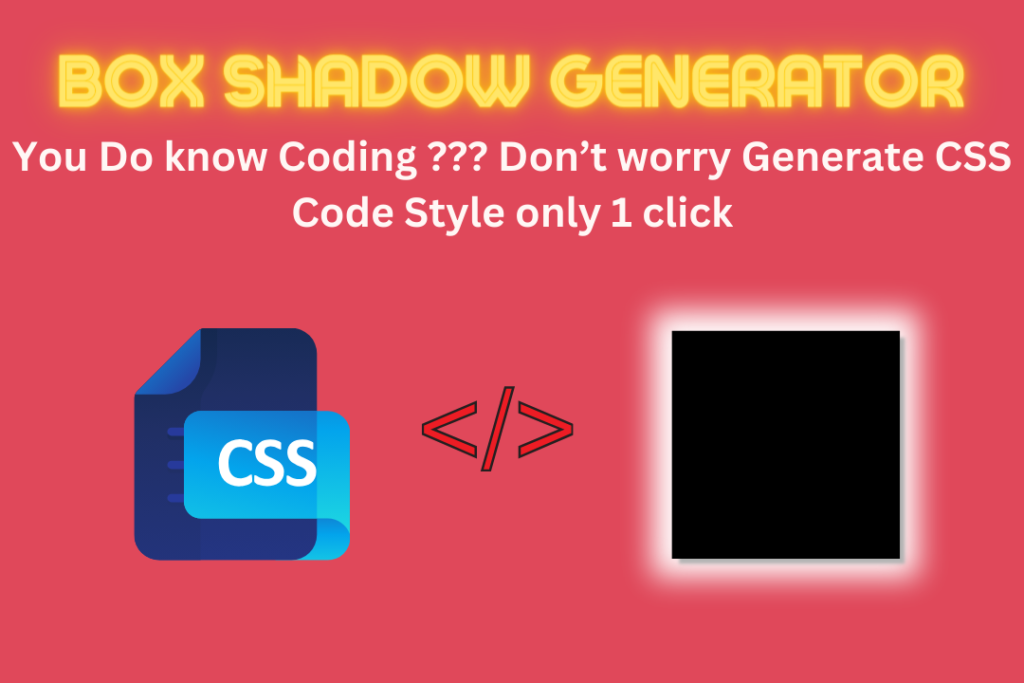Box Shadow Generator

Toolkits As Per Your Needs
A definitive Box Shadow Generator CSS: Hoist Your Designs with Dynamic Shadows
Introduction
In web design, creating outwardly engaging elements is significant to catching the consideration of users and passing on the expected message effectively. One such component that can fundamentally enhance the feel of a website is the box shadow. Box shadows add depth and dimension to various parts, causing them to show up more intuitive and locking in.
As a web designer or developer, having a solid tool available to generate and customize box shadows easily can smooth out your work process and assist you with accomplishing desired design results effectively. This is where a robust Box Shadow Generator CSS becomes an integral factor. In this far-reaching guide, we will investigate the meaning of box shadows in web design, dive into the functionalities of a box shadow generator, and give experiences in enhancing your designs utilizing this priceless tool.
Understanding Box Shadows Generator CSS in Web Design
Before diving into the complexities of box shadow generator CSS, embracing the idea of box shadows and their importance in web design is crucial. A box shadow is a special visualization applied to a component that creates the deception of depth by creating a shaded area behind it. This effect can be utilized to emphasize elements’ position, size, and height on a webpage, subsequently enhancing the general user experience.
Box shadows are flexible and can be custom-made to suit various design requirements. They can go from unpretentious shadows that add a sprinkle of depth to elements to intense shadows that make a dramatic effect. Moreover, box shadows can be customized concerning their position, size, blur radius, spread radius, and colour, allowing for vast potential outcomes in design investigation.
Key Features of a Box Shadow Generator CSS
An extensive box shadow generator CSS regularly offers many features and functionalities to engage users in creating dynamic and outwardly engaging box shadows. A few key features to pay special attention to include:
- Real-time Preview: A box shadow generator CSS should give a real-time preview of the shadow effect as you adjust various boundaries. This considers moment input and works with quick trial and error and various shadow arrangements.
- Customization Options: The capacity to customize boundaries like horizontal and vertical offset, blur radius, spread radius, and shadow colour is fundamental for fitting the box shadow to explicit design requirements. A decent generator offers natural controls for adjusting these boundaries definitively.
- Copy-to-Clipboard Functionality: Consistent joining with the clipboard empowers users to copy the generated CSS code with a solitary snap. This wipes out the requirement for manual coding and guarantees accuracy while executing the shadow effect in your activities.
- Multiple Shadow Support: High-level box shadow generator CSS might support the production of multiple shadows for a solitary component, allowing for more mind-boggling and layered shadow effects. This element is especially valuable for creating perplexing design compositions.
- Openness and Similarity: A box shadow generator CSS should focus on availability and guarantee similarity across various programs and devices. This guarantees that the generated shadow effects are steady and available to all users, regardless of their perusing climate.
Advancing Your Designs with Box Shadows
Now that we’ve investigated the basics of box shadows and the key features of a box shadow generator, we should investigate certain systems for upgrading your designs using this flexible tool.
- Enhancing Visual Order: Box shadows can be utilized decisively to lay out a visual progressive system inside your design. By applying unobtrusive shadows to unmistakable elements like buttons, cards, or route menus, you can cause users to notice them and guide them towards significant substance or activities.
- Creating Depth and Dimension: Adding box shadows to elements can make the deception of depth and dimension, causing your designs to feel more vivid and intuitive. Explore different avenues regarding different shadow arrangements to mimic light and shadow effects, subsequently enhancing the realism of your interface.
- Accentuating Intuitive Elements: Box shadows can feature intelligent elements, like buttons or connections when users drift over them. You can give visual criticism and support user commitment by enlivening the shadow effect or adjusting its properties on the float.
- Further developing Comprehensibility and Difference: When utilized reasonably, box shadows can enhance the lucidity of text and contrast against the foundation. Applying an unobtrusive shadow to text elements can create a feeling of detachment from the foundation, making the text more straightforward to peruse, particularly on light or occupied foundations.
- Creating Depth in Card-Based Formats: In card-based designs normally utilized in web design, box shadows can add depth and partition between individual cards. You can recreate the deck arrangement by applying shadows with differing powers or headings and make an outwardly engaging layered effect.
Conclusion
In conclusion, a Box Shadow Generator CSS is a significant tool for web designers and developers trying to hoist their designs with dynamic shadow effects. By understanding box shadows’ standards and tackling a robust generator’s capacities, you can enhance the visual allure, ease of use, and openness of your web projects.
Whether you mean to make unobtrusive shadows for a moderate design or intense shadows for a more dramatic effect, a box shadow generator engages you to release your innovativeness and rejuvenate your design vision. With its natural interface, real-time preview, and broad customization options, this fundamental tool makes certain to turn into a staple in your design toolkit.
So why pause? Plunge into the universe of box shadows and change your designs today with a definitive Box Shadow Generator CSS!
Popular Tools
- Age Calculator
- Word Count
- Bad & Toxic Backlink Checker
- Link Analysis Tool
- QR Code Generator
- File Downloader
- Internet Speed Test
- Secure Password Generator
- What is my IP
- Audio Recorder
- Text To Speech Converter
- Background Remover
- Screen Recording
- Image Compressor
- Image Resizer
- Drawing Canvas
- Notepad, Create Notes
- Typing Speed Test
- Pie Chart Maker
- Fancy Text Generator
- Website Speed Test
- Digital Signature
FAQ's
Why do we use box shadow in CSS?
Box shadows in CSS are utilized to add depth and dimension to elements on a webpage. They make enhanced visualizations that emulate the presence of elements creating shaded areas onto the foundation, accordingly enhancing the general design stylish and further developing user experience.
How do you prevent box shadow in CSS?
To forestall a box shadow from showing up on a component in CSS, you can set the box-shadow property to none or eliminate the property by and large. On the other hand, you can supersede existing box shadow styles with a more unambiguous selector or by setting the box-shadow property to 0 0 0 straightforward.
How do you control shadow boxes in CSS?
To control shadow boxes in CSS, you can utilize the box-shadow property, which acknowledges values for horizontal and vertical balances, blur radius, spread radius, and color. By adjusting these qualities, you can customize the presence of the box shadow to accomplish the desired effect.
Can you have multiple box shadows in CSS?
Indeed, you can have multiple box shadows in CSS by determining multiple box-shadow values isolated by commas. Each worth addresses a different box shadow effect, allowing you to layer shadows and make complex special visualizations.
